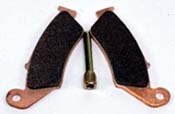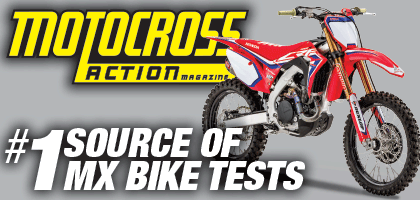MXA’S GUIDE TO BRAKE PADS

Improving your braking can be as simple as flushing the hydraulic system or as factory as running an oversized disc kit. However, to realize the most from your disc brakes, it is first necessary to grasp the inner workings of the system. When either the foot pedal or hand lever is engaged, a piston within the master cylinder pushes fluid into the brake hose. The fluid moves through the hose as a solid unit to the caliper. Pads within the caliper are engaged by the displaced fluid and clamp down on the disc rotor. Although oversimplified, that is really all there is to it.
SAFE TO ASSUME
ÿIt would be safe to assume that by now you are all too familiar with the numerous clich‚?ÿalluding to the fact that races are won in the turns and that braking is half the battle. So we’re going to refrain from heading off on some long tirade explaining how important it is to have strong brakes. We are quite confident that you already know that and are simply looking for an easier way to improve the stopping power you’ve already got. Can this be accomplished through a wiser choice in brake pads?
MANY PADS ARE ORGANIC
ÿIf the brake pad’s friction surface was made from a straight carbon-based, organic material, stopping performance would be poor and the brake system would quickly overheat. Actually, the pads wouldn’t do much more than polish the disc to an even, chrome-like luster (making straight-organic pads increasingly popular among the custom Harley elite). In order to find a suitable level of clasping force it was necessary to mix metal fragments into the organic base. This genre of brake pad is earmarked semi-metallic and has formed a strong following due to its consistent performance in dry and wet conditions.
ÿStandard semi-metallic pads wear rapidly and when cheaply made, the slower wearing metallic material results in raised, hard blemishes on the pad surface that will severely groove the disc. It’s necessary for semi-metallic pads to be backed with an asbestos-like shield to protect against the transfer of heat to the caliper. Most European bikes come standard with semi-metallic pads.
ORGANIC PLUS TWO
ÿIt has become popular for the producers of performance brake components to blend additional carbon and Kevlar ingredients in with the standard issue metallic bits and organic base material. When the mix is correct the result is a pad that stays consistently bonded, has controllable friction and offers superior heat dissipation. Some mixes disperse heat so well that they can only be used for unusually dry MX conditions (or for road racing). Kevlar/carbon pad, for example, rarely attains a suitable operating temperature in the wet going.
METAL MEETS METAL
ÿHonda, Kawasaki, Suzuki and Yamaha use sintered metal pads. Sintered describes the process of fusing metal particles into one mass by the application of pressure and heat. It’s a methodology that Dunlop, parent company to DP, introduced to the aircraft industry during WWII. Sintered metal pads offer unparalleled wet condition performance.
ÿObviously, rubbing metal particles against a metal disc sounds like the perfect equation for high wear. Frankly, it used to be too, until producers of sintered metal pads began increasing the percentage of soft, copper-like compounds to ease the impact on the disc. DP also adds a little bit of graphite to lend a lubricative quality that reduces wear and pad squeal.
ÿSintered pads generally create more heat and operate in a hotter environment than semi-metallic blends.
PAD MAINTENANCE
ÿMost of today’s ‘crossers use some kind of a metal tab that scrapes on the disc when the service limit of the pad has been met. This will generally be when only 2mm of material is left on the pad. Remember, this is an absolute service limit. Over a period of time pads will lose their performance from the endless heating and cooling cycles. The less remaining pad, the more the material will be compromised by heat. The factory teams won’t run pads longer than four races.
ÿBefore replacing pads, check if the rotor runs true. Warped, bent or heavily grooved rotors cause drag and will prematurely wear the pads as well as overheating the brake’s complete hydraulic system. Replace rotors that exceed the allowable runout listed in the service manual (usually anything in excess of 0.05mm). Don’t fret if the disc is discolored blue from excessive heat. As long as the disc runs true, performance will not suffer. Do, however, lightly scuff the binding surface of the rotor with emery cloth.
ÿIt’s a good idea to have a spare set of front and rear brake pads available at the races. Muddy and sandy conditions spell murder on pads, and some pro riders are lucky to get 30 minutes out of a set. Its best to start muddy motos with new pads.
MAKE YOUR BRAKES BETTER
ÿAftermarket brake pads can improve the braking on your bike, but only if you have conscientiously changed your brake fluid, bled the lines at regular intervals, checked the rotors and kept the system in good working order.
ÿThe quality of DP, EBC, SBS, White Bros., Bendix and Braking pads is exception. Plus these companies have the ability to develop special brake compounds for the motocross market (the MXA test crew has ridden with very grippy pads from some pad companies that are designed to guarantee that the bike stops instantly — often these pads are sold as special models). However, if you ride a Honda, don’t expect a massive change with a simple change of brake pads. Suppliers of performance pads are the first to admit that Honda’s pad makeup is hard to top. However, a switch to aftermarket pads will improve binding force on YZs, KXs and RMs. Expect a giant performance gain after replacing KTM, Husaberg or Husqvarna semi-metallic pads with racing pads. Always retain the OEM’s heat shield insert when changing pads.





Comments are closed.